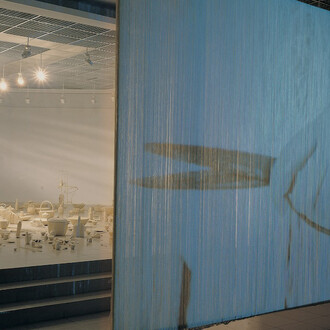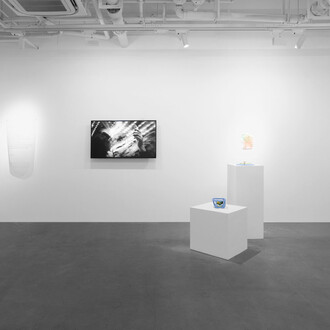My works are messengers from the Valley, like thoughts sowing a vision for the future.
(Fabrice Hyber)
From April 2, to June 29, 2025, Power Station of Art and the Fondation Cartier pour l’art contemporain in Paris, France present … de la vallée, the monographic exhibition of French artist Fabrice Hyber. Following a successful debut in Paris at the Fondation Cartier pour l’art contemporain in 2022, this exhibition features over 70 works that span from the 1990s to the artist’s most recent pieces, including more than 20 works specifically created for this occasion.
Through this exhibition, the artist metaphorically and physically transports to Shanghai his homeland where he lives and works in the West of France.
Fabrice Hyber and his valley
Artist, sower, entrepreneur, poet, Hyber is the author of a prolific body of work that comprises paintings, performances, installations, businesses. Flouting categories, he takes art into all spheres of existence: mathematics, neuroscience, agroforestry, history, astrophysics, as well as love, the body, and the evolution of living species.
The multiple dimensions of Hyber’s art find their origins in the forest he has been cultivating since the 1990s in the heart of the Vendean countryside, surrounding the former house of his parents, who were sheep farmers. Some 300,000 tree seeds, from several hundred different species, have been sown using a carefully perfected technique, and have gradually transformed what was once agricultural land into a forest of more than a hundred of hectares. The landscape, in other words, has become a work of art.
This very special place is both a laboratory of ideas, a workshop and a natural refuge, yet one that the artist has created from scratch. A place of learning and experimentation, the vallée has become the matrix and source of inspiration for the entire body of work of the artist, who readily compares his practice to the organic growth of living organisms: “I sow trees just as I sow signs and images. (…) I sow seeds of thought that are visible, they make their way and grow. I am no longer their master.” Sowing, growing, working with others, making people think are the essence of this exhibition.
By installing his valley in China for three months, Hyber added more meaning to the concept, that he will later bring back home, benefiting from this back-and-forth movement across cultures and geographies, just as he always does in his practice. He feeds his work and universe with the knowledge and the encounters he gathers along the way, while sowing seeds in each visitor’s mind.
A forest inhabited by hyber heroes
"Steadfast yet simple, vast yet embracing like a valley"-for the Chinese philosopher Lao Tzu, the valley is a posture of humility that lets one come to oneself. In the same way, in Fabrice Hyber's vallée, everything converges: water, fauna, flora, artists and thinkers. Hyber invites artists and scientists in residency and regularly hosts workshops with schoolkids and students. This is an inhabited forest, both created and occupied by man.
The human presence is felt from the moment you enter the exhibition at PSA. Numerous works are a metaphor for this. The green and inflated giant “Ted Hyber” (pun inspired by Teddy bear) stands as the self-portrait of the artist, at the center of a garden. Pre-existing cracks painted over by the artist spread out from the giant sculpture, as if he had stepped on the floor of the former disused thermal power station occupied by the PSA, and irrigate the exhibition. Parallel waves of knowledge, ideas and projects propagate from this central character and travel through the whole exhibition. Hyber heroes costumes populate the forest glades recreated in the exhibition, and everyone can identify to their postures.
A garden of paintings
Painting is a starting point for each of his projects and contains the seeds of future works. On large-format canvases set up in his studio, Hyber formulates hypotheses, juxtaposes ideas, invents forms, and plays with words: “Since I started painting, I use a lot of water and very little material. This yields some incredible effects, and very light canvases. My oil paintings are essentially watercolors. There is very little intervention in the end.” Going from one painting to another, the artist jots down a sentence here, draws an image there, glues an object elsewhere, according to his imagination and conjecture.
This time, Fabrice Hyber enjoyed painting on ceramic panels in Jingdezhen, the city of Chinese porcelain. Some new enameled ceramics produced on the occasion of this collaboration will be presented for the first time in the exhibition.
Some 36 free-standing paintings and a dozen of ceramic panels mounted on wheels recall school blackboards and invite us to sit, read, learn and question Hyber’s many interests: Nature, cosmos, mathematics, architecture, poetry. The exhibition turns into a new type of school, open to any possibilities, and transforms visitors into students.
An exhibition-school
I have always considered my canvases to be like classroom blackboards, like those where we learn to dissect knowledge through teachers and researchers. Mine offer other worlds, whether possible or impossible. In this exhibition, I chose to install my works instead of blackboards in this ideal school setting.
(Fabrice Hyber)
Fabrice Hyber imagined this exhibition as a kind of school, in the effort to share this other way of learning born in the Valley. Fabrice Hyber stages various ways of learning from a painting. In the short videos that accompany the works, the artist reveals the mental journey that presided over their creation.
If … de la vallée is a forest, it is also a school. With this in mind, during the exhibition, weekly public programs such as “Valley Classroom”, “Valley Lab”, and “'Neuromancer' Slow-looking Session” will be open to visitors of all ages, offering a multidimensional experience of the art and knowledge within Hyber's works.
A series of talks given by specialists of subjects that Fabrice Hyber is examining in his work will give the public many opportunities to examine their expertise against the hypotheses Fabrice Hyber puts forth on his canvases. By bringing together philosophers, architects, mathematicians, neuroscientists, medical anthropologists, evolutionary biologists, as well as the practitioners deeply engaged in sustainable agriculture, local plant conservation, and wildlife protection, “… de la vallée” generates various forms of knowledge, reflecting the range of Hyber’s artistic practice.
















